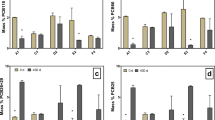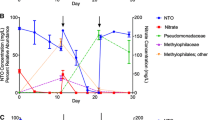Abstract
A novel anaerobic consortium, named DehaloR^2, that performs rapid and complete reductive dechlorination of trichloroethene (TCE) to ethene is described. DehaloR^2 was developed from estuarine sediment from the Back River of the Chesapeake Bay and has been stably maintained in the laboratory for over 2 years. Initial sediment microcosms showed incomplete reduction of TCE to DCE with a ratio of trans- to cis- isomers of 1.67. However, complete reduction to ethene was achieved within 10 days after transfer of the consortium to sediment-free media and was accompanied by a shift to cis-DCE as the prevailing intermediate metabolite. The microbial community shifted from dominance of the Proteobacterial phylum in the sediment to Firmicutes and Chloroflexi in DehaloR^2, containing the genera Acetobacterium, Clostridium, and the dechlorinators Dehalococcoides. Also present were Spirochaetes, possible acetogens, and Geobacter which encompass previously described dechlorinators. Rates of TCE to ethene reductive dechlorination reached 2.83 mM Cl− d−1 in batch bottles with a Dehalococcoides sp. density of 1.54E+11 gene copies per liter, comparing favorably to other enrichment cultures described in the literature and identifying DehaloR^2 as a promising consortium for use in bioremediation of chlorinated ethene-impacted environments.




Similar content being viewed by others
References
Abelson PH (1990) Inefficient remediation of groundwater pollution. Science 250:733
Abrahamsson K, Ekdahl A, Collen J, Pedersen M (1995) Marine algae—a source of trichloroethylene and perchloroethylene. Limnol Oceanogr 40:1321–1326
Amos BK, Ritalahti KM, Cruz-Garcia C, Padilla-Crespo E, Loffler FE (2008) Oxygen effect on Dehalococcoides viability and biomarker quantification. Environ Sci Technol 42:5718–5726
Ashelford KE, Chuzhanova NA, Fry JC, Jones AJ, Weightman AJ (2006) New screening software shows that most recent large 16S rRNA gene clone libraries contain chimeras. Appl Environ Microbiol 72:5734–5741
Cummings DE, Snoeyenbos-West OL, Newby DT, Niggemyer AM, Lovley DR, Achenbach LA, Rosenzweig RF (2003) Diversity of Geobacteraceae species inhabiting metal-polluted freshwater lake sediments ascertained by 16S rRNA gene analyses. Microb Ecol 46:257–269
Cupples AM, Spormann AM, McCarty PL (2004) Comparative evaluation of chloroethene dechlorination to ethene by Dehalococcoides-like microorganisms. Environ Sci Technol 38:4768–4774
DeSantis TZ, Hugenholtz P, Keller K, Brodie EL, Larsen N, Piceno YM, Phan R, Andersen GL (2006) NAST: a multiple sequence alignment server for comparative analysis of 16S rRNA genes. Nucleic Acids Res 34:W394–W399
Duhamel M, Edwards EA (2006) Microbial composition of chlorinated ethene-degrading cultures dominated by Dehalococcoides. FEMS Microbiol Ecol 58:538–549
Duhamel M, Edwards EA (2007) Growth and yields of dechlorinators, acetogens, and methanogens during reductive dechlorination of chlorinated ethenes and dihaloelimination of 1,2-dichloroethane. Environ Sci Technol 41:2303–2310
Freeborn RA, West KA, Bhupathiraju VK, Chauhan S, Rahm BG, Richardson RE, Alvarez-Cohen L (2005) Phylogenetic analysis of TCE-dechlorinating consortia enriched on a variety of electron donors. Environ Sci Technol 39:8358–8368
Haest PJ, Springael D, Smolder E (2010) Dechlorination kinetics of TCE at toxic TCE concentrations: Assessment of different models. Water Research 44:331–339
Griffin BM, Tiedje JM, Loffler FE (2004) Anaerobic microbial reductive dechlorination of tetrachloroethene to predominately trans-1,2-dichloroethene. Environ Sci Technol 38:4300–4303
Heidler J, Sapkota A, Halden RU (2006) Partitioning, persistence, and accumulation in digested sludge of the topical antiseptic triclocarban during wastewater treatment. Environ Sci Technol 40:3634–3639
Holmes VF, He JZ, Lee PKH, Alvarez-Cohen L (2006) Discrimination of multiple Dehalococcoides strains in a trichloroethene enrichment by quantification of their reductive dehalogenase genes. Appl Environ Microbiol 72:5877–5883
Huber T, Faulkner G, Hugenholtz P (2004) Bellerophon: a program to detect chimeric sequences in multiple sequence alignments. Bioinformatics 20:2317–2319
Johnson DR, Nemir A, Andersen GL, Zinder SH, Alvarez-Cohen L (2009) Transcriptomic microarray analysis of corrinoid responsive genes in Dehalococcoides ethenogenes strain 195. FEMS Microbiol Lett 294:198–206
Kittelmann S, Friedrich MW (2008a) Identification of novel perchloroethene-respiring microorganisms in anoxic river sediment by RNA-based stable isotope probing. Environ Microbiol 10:31–46
Kittelmann S, Friedrich MW (2008b) Novel uncultured Chloroflexi dechlorinate perchloroethene to trans-dichloroethene in tidal flat sediments. Environ Microbiol 10:1557–1570
Lee PKH, Macbeth TW, Sorenson KS, Deeb RA, Alvarez-Cohen L (2008) Quantifying genes and transcripts to assess the in situ physiology of “Dehalococcoides” spp. in a trichloroethene-contaminated groundwater site. Appl Environ Microbiol 74:2728–2739
Loffler FE, Sun Q, Li JR, Tiedje JM (2000) 16S rRNA gene-based detection of tetrachloroethene-dechlorinating Desulfuromonas and Dehalococcoides species. Appl Environ Microbiol 66:1369–1374
Loffler FE, Sanford RA, Ritalahti KM (2005) Enrichment, cultivation, and detection of reductively dechlorinating bacteria. Environ Microbiol 397:77–111
Ludwig W, Strunk O, Westram R, Richter L, Meier H, Yadhukumar BA, Lai T, Steppi S, Jobb G, Forster W, Brettske I, Gerber S, Ginhart AW, Gross O, Grumann S, Hermann S, Jost R, Konig A, Liss T, Lubmann R, May M, Nonhoff B, Reichel B, Strehlow R, Stamatakis A, Stuckmann N, Vilbig A, Lenke M, Ludwig T, Bode A, Schleifer KH (2004) ARB: a software environment for sequence data. Nucleic Acids Res 32:1363–1371
Macbeth TW, Cummings DE, Spring S, Petzke LM, Sorenson KS (2004) Molecular characterization of a dechlorinating community resulting from in situ biostimulation in a trichloroethene-contaminated deep, fractured basalt aquifer and comparison to a derivative laboratory culture. Appl Environ Microbiol 70:7329–7341
McCarty PL (1997) Microbiology—breathing with chlorinated solvents. Science 276:1521–1522
Miller GS, Milliken CE, Sowers KR, May HD (2005) Reductive dechlorination of tetrachloroethene to trans-dichloroethene and cis-dichloroethene by PCB-dechlorinating bacterium DF-1. Environ Sci Technol 39:2631–2635
Miller TR, Heidler J, Chillrud SN, DeLaguild A, Ritchie JC, Mihalic JN, Bopp R, Halden RU (2008) Fate of triclosan and evidence for reductive dechlorination of triclocarban in estuarine sediments. Environ Sci Technol 42:4570–4576
Richardson RE, Bhupathiraju VK, Song DL, Goulet TA, Alvarez-Cohen L (2002) Phylogenetic characterization of microbial communities that reductively dechlorinate TCE based upon a combination of molecular techniques. Environ Sci Technol 36:2652–2662
Ritalahti KM, Amos BK, Sung Y, Wu QZ, Koenigsberg SS, Loffler FE (2006) Quantitative PCR targeting 16S rRNA and reductive dehalogenase genes simultaneously monitors multiple Dehalococcoides strains. Appl Environ Microbiol 72:2765–2774
Schaefer CE, Condee CW, Vainberg S, Steffan RJ (2009) Bioaugmentation for chlorinated ethenes using Dehalococcoides sp.: comparison between batch and column experiments. Chemosphere 75:141–148
Schloss PD, Westcott SL, Ryabin T, Hall JR, Hartmann M, Hollister EB, Lesniewski RA, Oakley BB, Parks DH, Robinson CJ, Sahl JW, Stres B, Thallinger GG, Van Horn DJ, Weber CF (2009) Introducing mothur: open-source, platform-independent, community-supported software for describing and comparing microbial communities. Appl Environ Microbiol 75:7537–7541
Schlotelburg C, von Wintzingerode C, Hauck R, von Wintzingerode F, Hegemann W, Gobel UB (2002) Microbial structure of an anaerobic bioreactor population that continuously dechlorinates 1,2-dichloropropane. FEMS Microbiol Ecol 39:229–237
Taş N, Eekert MHA, Vos WM, Smidt H (2009) The little bacteria that can—diversity, genomics and ecophysiology of ‘Dehalococcoides’ spp. in contaminated environments. Microb Biotechnol 3:389–402
Torres CI, Krajmalnik-Brown R, Parameswaran P, Marcus AK, Wanger G, Gorby YA, Rittmann BE (2009) Selecting anode-respiring bacteria based on anode potential: phylogenetic, electrochemical, and microscopic characterization. Environ Sci Technol 43:9519–9524
Vainberg S, Condee CW, Steffan RJ (2009) Large-scale production of bacterial consortia for remediation of chlorinated solvent-contaminated groundwater. J Ind Microbiol Biotechnol 36:1189–1197
Wolcott RD, Gontcharova V, Sun Y, Dowd SE (2009) Evaluation of the bacterial diversity among and within individual venous leg ulcers using bacterial tag-encoded FLX and titanium amplicon pyrosequencing and metagenomic approaches. BMC Microbiol 9:226
Xiu ZM, Jin ZH, Li TL, Mahendra S, Lowry GV, Alvarez PJJ (2010) Effects of nano-scale zero-valent iron particles on a mixed culture dechlorinating trichloroethylene. Bioresour Technol 101:1141–1146
Zhang H, Banaszak JE, Parameswaran P, Alder J, Krajmalnik-Brown R, Rittmann BE (2009) Focused-pulsed sludge pre-treatment increases the bacterial diversity and relative abundance of acetoclastic methanogens in a full-scale anaerobic digester. Water Res 43:4517–4526
Zhang HS, Ziv-El M, Rittmann BE, Krajmalnik-Brown R (2010) Effect of dechlorination and sulfate reduction on the microbial community structure in denitrifying membrane-biofilm reactors. Environ Sci Technol 44:5159–5164
Zhao YG, Ren NQ, Wang AJ (2008) Contributions of fermentative acidogenic bacteria and sulfate-reducing bacteria to lactate degradation and sulfate reduction. Chemosphere 72:233–242
Zhou JZ, Davey ME, Figueras JB, Rivkina E, Gilichinsky D, Tiedje JM (1997) Phylogenetic diversity of a bacterial community determined from Siberian tundra soil DNA. Microbiology-Uk 143:3913–3919
Acknowledgments
The authors thank Husen Zhang for guidance on the pyrosequencing and Prathap Parameswaran for guidance on the clone library construction. The project described was made possible in part by Award Number R01ES015445 from the National Institute of Environmental Health Sciences (NIEHS) and by start-up funds provided by the Arizona State University Fulton Schools of Engineering. The content is solely the responsibility of the authors and does not necessarily represent the official views of the NIEHS or the National Institutes of Health.
Author information
Authors and Affiliations
Corresponding author
Rights and permissions
About this article
Cite this article
Ziv-El, M., Delgado, A.G., Yao, Y. et al. Development and characterization of DehaloR^2, a novel anaerobic microbial consortium performing rapid dechlorination of TCE to ethene. Appl Microbiol Biotechnol 92, 1063–1071 (2011). https://doi.org/10.1007/s00253-011-3388-y
Received:
Revised:
Accepted:
Published:
Issue Date:
DOI: https://doi.org/10.1007/s00253-011-3388-y




